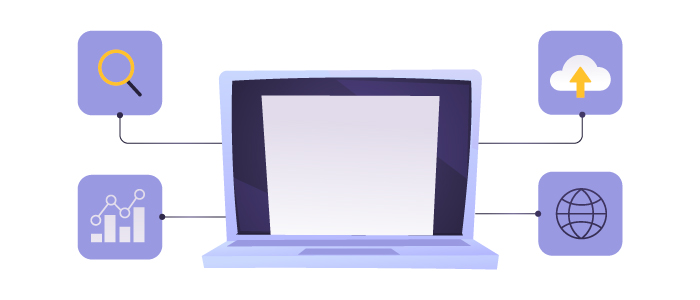Top Content Marketing Best Practices for B2B & B2C
If you came here, you must have heard that content is king at least once. But let us face it: not all content wears the crown equally, and there is no king’s road to reaching the top regarding content marketing. It takes effort and commitment, along with learning about the content marketing best practices for B2B and B2C.
Whether you are a newcomer or a seasoned pro, staying updated is key to sharpening your content strategy.
In this article, we will provide you with 20 content marketing practices you can implement in your own activity. Keep reading to discover what strategies might work best for you!
20. Content Marketing Success Stands in Templates

Have you recently checked how your articles are performing? Have you noticed that some consistently outshine the rest?
If you are struggling to identify what you are doing wrong with your content and want to improve your performance, you have stumbled upon something effective for your content strategy. Thus, explore and analyze further what sets these articles apart. Look closely at their subject matter, keywords, and writing style.
Once you have identified the factors that lead to success, transform them into reusable templates. This will leverage your success and maximize your full potential. Templates are an excellent solution for balancing scalability, customization, and, ultimately, creating a faster and more stable work cycle.
Most importantly, outlining several templates dedicated to defined goals will save you time in content production as well as optimization.
19. Create Captivating Headlines
Crafting compelling and catchy headlines is essential for attracting traffic and generating leads. These headlines serve as the first point of contact with potential readers, influencing their decision to engage with your content.
Effective headlines spark interest and inform the audience about the content’s value. Try incorporating numbers in headlines to enhance their appeal and clarity and increase click-through rates. Additionally, keeping headlines concise and simple improves readability and SEO performance.
Also, use a headline analyzer to gain a deeper insight into your headline’s performance.
18. Optimize Your Website’s Interface
One of the most important content marketing best practices is related to usability. Having a poor user experience and a hard-to-use interface can really slow down your content marketing efforts and put a dent in your business if it is not fixed. It can even scare away online consumers who have had a bad time, which will lead to fewer return visits from those who have had a bad experience.
But fear not! Improving UI/UX is like giving your website a user-friendly interface could boost conversion rates, making the user journey smoother than butter. By improving your website interface, turning casual visitors into paying customers becomes a breeze.
So, why wait? Optimizing the website interface is like adding sprinkles to your content cupcake; it clarifies, stirs up emotions, and facilitates navigation.
17. Optimize Your Content for Mobile
Nowadays, mobile internet traffic stands at around 59%. Furthermore, consumers are like digital nomads, hopping from one device to another as they browse and shop online. It is super important to make sure every online touchpoint, especially mobile, is optimized to turn visitors into buyers.
But wait, being “mobile-friendly” is not the same as being “mobile-optimized.” A mobile-friendly website functions on mobile devices, but mobile optimization takes it to the next level. It is like giving your site a makeover, making it fit smaller screens and super easy to navigate. Everything, from images to layout, is fine-tuned to fit perfectly on any screen size.
And guess what? Mobile optimization does not just improve your site; it also makes it more user-friendly, attracting more visitors and keeping them engaged. So, don’t just meet expectations; exceed them with a mobile-first approach and watch your business gain a significant advantage over the competition.
16. Stay Tuned for Algorithm Changes

Perhaps the best source for massive traffic on your website to gain exposure to your content is represented by search engines. So, search engine algorithms are like secret recipes that are constantly evolving to deliver better results and combat spam and manipulation.
But do not worry; you can stay ahead of the game by keeping an eye on these algorithm updates. They are like little clues that help you understand what is happening in the world of SEO.
Now, some people might think of these updates as a bit of a punishment, but they are not! Keeping an eye on Google algorithm updates acts as a guide, helping you navigate the ever-changing landscape of search engine rankings.
If you are not paying attention, you might lose your spot on the SERP.
15. Refresh Old Content
Before creating newer content, it is essential to check how well your current content is doing. This helps determine if any of your older content needs a refresh or if it is time to repurpose it. There is no need to create new content if your current content is already high-quality.
Some adjustments in your keywords and ensuring all data is up to date might be all it takes.
While evaluating your current content, you may also discover gaps where fresh content could shine or where merging existing pieces could enhance performance. Conducting a content audit is key to discovering hidden gems and identifying opportunities for updates, optimizations, or new content.
Opting to repurpose or re-optimize your content can extend its reach, increase engagement, and even save on production costs. Plus, repurposed content has the potential to reach an entirely new audience.
14. Hunt Down Content Gaps
Among the essential best practices in content marketing, content gaps stand out the most because they’re a great way to identify content ideas that your competitors rank for but do not.
While your current content pillars might cover a lot, there is always more ground to explore. During your content plan research, look for these content gaps; they are opportunities waiting to be seized.
13. Identify Top Content & Web Metrics
You can’t know if you’re going the right way if you don’t do any kind of tracking. Content and web metrics are like your content’s GPS, helping you navigate its performance and progress across various key areas such as lead generation, organic traffic, sign-ups, sales, awareness, resolving content gaps, and improving SERP ranking.
They provide valuable insights, showing you where you are excelling and where there’s room for improvement. By keeping an eye on content marketing KPIs, you can steer your content strategy in the right direction and ensure you are on track to meet your goals.
12. Collaboration & Trust

Crafting effective content for your business takes more than one person. It involves collaboration with design, product, development, legal, and even SEO teams. In any organization, aligning these departments toward the shared goal of increasing brand exposure through effective communications is crucial.
Even so, you should establish clear goals across departments to prioritize responsibilities correctly and avoid delays in content creation or other processes.
11. Keep an Eye on Trends
Trends tend to get clout for a while. As a marketer, you can use that to attract new customers and grow your business both online and offline by jumping on the bandwagon. Understanding and adapting to these changes is essential for gaining increased exposure at a minimum cost.
Use Google Trends to see what people are searching for. By appearing in search results related to those keywords, you may gain visibility and traffic.

Last but not least, trends might come and go, but their impact can linger; by creating evergreen content that ties into trending topics, you ensure that the content remains relevant over time.
10. Expand Reach & Engagement Through New Channels
Experimenting with new platforms and channels will spice up your marketing goals and is the main key to reaching new audiences and testing the latest ideas to optimize your marketing strategy. However, before diving in, it is essential to have a clear idea of your goals and how you will evaluate your results.
While trying out new channels can be time-consuming and may not always lead to immediate growth, it can provide valuable insights and feedback to enhance your marketing effectiveness.
By exploring new channels, you can uncover new opportunities and reach a broader audience, reducing reliance on a single marketing channel and embracing diversification.
9. Keyword Research, the Path to Success
Keyword research is not just about finding words; it is about uncovering hidden treasures that will enhance your content creation! Tools like Ahrefs or Keyword Surfer can make your job easier. Dive into search volume, click volume, and keyword difficulty to discover the most suitable keywords for your content.
Each keyword presents an opportunity for unique content exploration. While it is tempting to look at competitors for inspiration, avoid outright copying. Instead, focus on identifying gaps or areas where you can excel by creating your own content.
8. Map Out Your Buyer’s Journey

Call it a customer journey, buyer journey, sales process, or whatever feels more proper for your business. In any case, it’s essential to sit down and put it on paper and describe every stage of your customer’s journey.
This way, you can generate content ideas that match your customers’ needs and provide answers to questions they may not even know they have. Attention to detail like this can really put you on the front foot.
7. Create Content for Your Customer Journey
Of course, mapping out the customer journey is just one step. Understanding the buyer’s journey is super important when we discuss content marketing best practices.
In a most simplified model, every person who has a problem goes through a journey that starts with the awareness stage. This is when they realize they have pain points, and your content should aim to establish authority and build trust. Your content needs to shine here, showing that you are the expert and winning trust.
Next comes the consideration stage, where people are checking out potential fixes. Your content should be like a helpful buddy, giving them valuable insights to guide their decision-making process.
Last is the decision stage, where the buyer is ready to make a move and close the deal. Your content should be all about flaunting your products or services and shouting about why they’re awesome.
By customizing your content for each stage of the buyer’s journey, you will keep it fresh, exciting, and spot-on, leading to more fist bumps (aka conversions)!
6. Set Goals, See Results
If you cannot find a goal to support your desired content, put it back on the backlog and keep the idea for later. How do you know if your content marketing efforts are effective and aligned with the business objective? Well, the answer is to set goals for every piece of content.
Why? Create clarity to the purpose, focus on the resources, and motivate the team. That way, it will be much easier to define what you want to achieve, know how to measure it, and when you will reach it.
Specific goals help enable us to track the performance, identify gaps, and adjust the strategy needed. Without an established goal, the goal is going to do very little for the brand.
5. Write Content Based on User Search Intent
Great content solves problems. You are eager to uncover what the consumer craves, right? Well, the trick is to whip up content that tackles their problems. To do that, you can focus on creating content that addresses questions and gives out the perfect pieces to solve their dilemmas.
While you might not close the deal with every piece of content, you can certainly spot behaviors that hint at a potential purchase. Getting to know your audience inside out is a good tip for making smart decisions about your content.
4. Establish a Content Strategy

We’ve implied several times that you need a content strategy. But to emphasize the importance of a coherent content marketing strategy, we will include it in our top 5 content marketing best practices. With a clear strategy in place, you ensure your content takes the stage and communicates its significance to all stakeholders.
Think of a robust content strategy as your roadmap to success, plotting out each crucial step toward your goals. Crafting such a strategy demands meticulous planning, flawless execution, and input from every corner of your organization.
Sure, it is a journey that takes time, but the sooner you embark on it, the sooner you will have a winning strategy ready to conquer your objectives!
3. Set Expectations in Your Content Approaches
Crafting content that resonates with your client’s goals and expectations is crucial. Successful content marketing hinges on deeply understanding and addressing your customers’ needs, goals, and challenges.
To position your brand effectively, rally your internal teams around meeting these specific needs.
Customers come with various needs and problems, so listen closely to develop products that suit them. Prioritize providing solutions in your content creation and consider your typical customer’s emotional perspective. Understanding your audience better is key to business growth.
2. Produce Content that Stands Out
Everyone wants their content to stand out the most, and this is perhaps one of the most known and applied content marketing best practices. However, it’s not easy to do it.
Producing captivating content involves leveraging a variety of tools and techniques, from strategic headlines to engaging storytelling and multimedia elements. It is about giving your readers something valuable by addressing their needs and interests, thereby holding their attention and encouraging further engagement.
So, start by understanding your audience’s preferences and tailoring content accordingly. At the end of the day, your audience will be interested in your content, and it will stand out only if your content, in the first place, is relevant.
Relevant content grabs attention, builds brand credibility, fosters emotional connections, and drives long-term growth. Therefore, having a clear understanding of your audience demographics and preferences, along with a purpose-driven content strategy, is key to creating content that resonates and delivers results.
1. AI Generated Content

Now, let’s talk about the hottest content marketing best practice, AI-generated content. Do you remember the movie S1m0ne from 2002? Well, in 2024, S1m0ne is here. How?
Well, AI-generated content is quickly becoming a trend in content creation, and it looks like this trend is here to stay because it makes life much easier in many ways. AI services like ChatGPT can be used for research, creating schemas, or generating content ideas. Also, the paid version allows you to generate AI images via GPT4.

For example, the image above is generated with Chat GPT4, but you have a plethora of tools online, like Midjourney, DALL-E, Stable Diffusion, and derivatives that can create images and videos.
Believe it or not, nowadays, several media agencies are already exploring AI influencers. Possibly, the hottest content marketing best practice is generating content with AI, not just articles but photos and videos as well. You can literarily build your own internet AI influencer.
However, it is not recommended to rely solely on these services to create your content. The human touch is what gives this content personality.
Conclusion
Now that we’ve concluded our list of 20 content marketing best practices, we should emphasize that your activity might benefit from some of them more than others. So, feel free to choose the ones that make the most sense for your activity.
In our case, we focus a lot on research, strategy, and collaboration. Although we are fans of AI and are looking forward to what it will do in the future, we still like to create our content on our own. That’s us!
So, please tell us in the comment section what content marketing best practices you’re using or planning to use if you’ve experimented with AI yet and how it was.